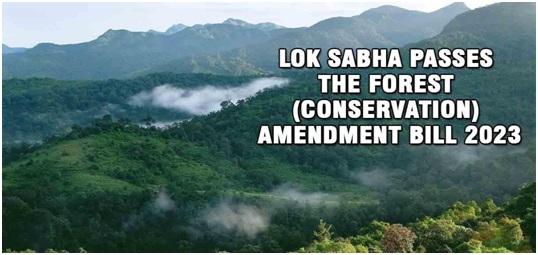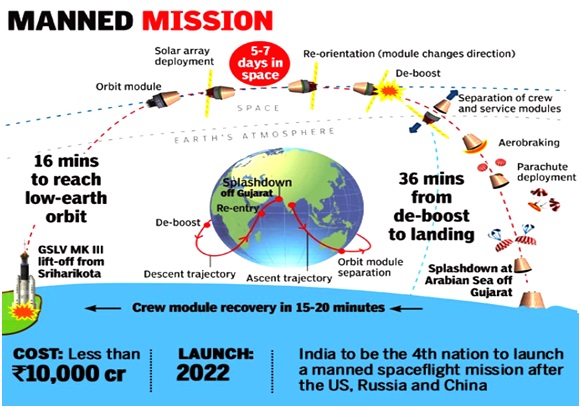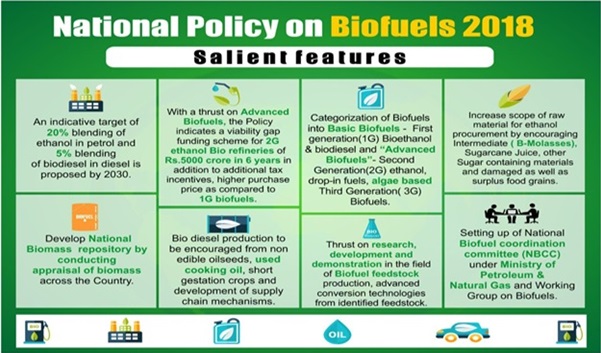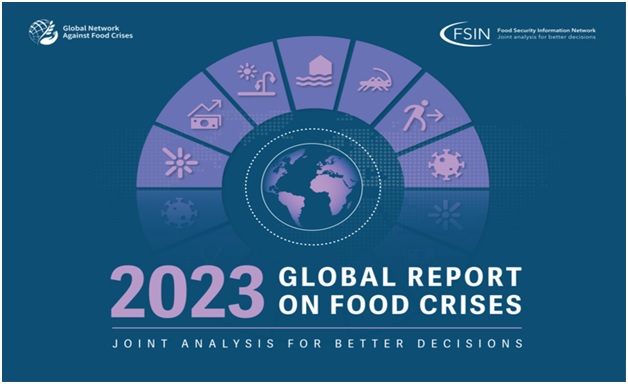The Forest (Conservation) Amendment Bill, 2023 (The Hindu)

- 28 Jul 2023
Why in the News?
Amidst pandemonium, the Lok Sabha passed the Forest Conservation (Amendment) Bill on July 26, without any changes from the version first introduced on March 29. The contentious Bill was introduced to amend the Forest Conservation Act, 1980.
Context:
- The Forest (Conservation) Act, 1980, was enacted to prevent large-scale deforestation and mandates central government approval for diverting forest land for non-forest purposes.
- The pressure on forest land has increased due to various factors like industry demands, agriculture, and the need for forest produce, as noted by the Standing Committee on Science and Technology, Environment, and Forests (2019).
- The Forest (Conservation) Amendment Bill alters the criteria for including and excluding forest land from the Act's scope, presenting modifications to address the evolving challenges faced in forest conservation.
What is The Forest (Conservation) Act 1980?
- The Forest (Conservation) Act of 1980 was implemented to safeguard India's forest land from unauthorized encroachments for non-forestry activities.
- It grants the Central government the authority to demand appropriate compensation when forest land is diverted for non-forestry purposes.
- Furthermore, the Act extends its scope to encompass areas not officially classified as "forest" in State or Central government records.
Need for the recent amendments:
- The process of obtaining forest-clearance approval in India is challenging, involving significant delays and potential corruption.
- Inconsistent land records add to the complexity, as parcels marked as forests in one record may have different classifications elsewhere.
- A court order inadvertently discouraged states from reclassifying forests, complicating matters further.
- The amendments aim to eliminate ambiguities and provide clear guidelines for the Act's application to different types of lands.
Key Features of the Forest (Conservation) Amendment Bill, 2023:
- Land under the Act:
- The Bill includes two categories of land under its purview, including officially declared forest land and land notified as a forest after October 25, 1980.
- Exemptions:
- Certain land types, such as forest land along railways or public roads maintained by the government, are exempted from the Act's provisions.
- Assignment/Leasing of Forest Land:
- Prior approval of the central government is required for assigning forest land to any entity, including those owned and controlled by the government, with specific terms and conditions.
- Permitted Activities:
- The Bill expands the list of activities excluded from non-forest purposes, including zoos, ecotourism facilities, silvicultural operations, and others specified by the central government.
- Power to Issue Directions:
- The central government may issue implementation directions to any recognized authority or organization under the central, state, or union territory.
Upsides of the Forest Amendment Bill:
- Certain amendments outline exclusions where the Act won't apply.
- Other amendments promote plantation cultivation on non-forest land, potentially increasing tree cover, acting as a carbon sink, and supporting India's emissions reduction goals.
- The bill would lift restrictions on infrastructure development for national security and livelihood opportunities for forest-adjacent communities.
Environmentalists' Concerns with the Forest Amendment Bill:
- Changing the Act's name to Van (Sanrakshan Evam Samvardhan) Adhiniyam raises confusion.
- Reclassifying forest areas may invalidate past judgments and reduce protection for vast forest tracts.
- The Bill doesn't consider the real scenario of deforestation and its impact on ecological functions.
- Exemptions in border areas may hinder the rights of forest-dwelling tribes and reduce the necessity of forest clearances.
- The Bill was referred to a joint committee instead of the standing committee, raising concerns about the potential lack of scrutiny.
Government's Intention with the Forest Amendment Bill:
- The government sees this as a crucial opportunity to address a 27-year-old policy deadlock that hinders growth and employment while not effectively conserving forests.
- The amendments are necessary to align with India's evolving ecological, strategic, and economic aspirations. They aim to:
- Support India's objective of increasing forest and tree cover to a third of its land area.
- Help achieve Net Zero emissions by 2070 and enhance forest carbon stocks through sustainable development.
- Create a carbon sink of 2.5-3 billion tonnes of CO2-equivalent by 2030 under the Nationally Determined Contribution targets.
- Enable the act to address emerging ecological challenges related to forest conservation, restoration, compensatory mechanisms, and mitigation measures.
Striking a Balance between Forest Conservation and Economic Activities:
- The 1980 Act aimed to combat deforestation, necessitating central government approval for diverting forest land for non-forest purposes. Additionally, only certain conservation and wildlife management activities were allowed without prior approval.
- The Bill introduces new activities like silvicultural operations, safaris, and eco-tourism facilities to this list. It also permits certain surveys without central government approval.
- These activities can contribute to economic development and align with national priorities such as energy security and industrial growth, especially in cases like mineral prospecting.
- However, achieving a balance between economic benefits and forest conservation is crucial. The shift from case-by-case examination by the central government to a blanket exemption raises questions about the mechanism for striking this balance.
The Forest (Conservation) Amendment Bill, 2023, warrants meticulous examination to reconcile the noble aspirations outlined in its Preamble with the possible detrimental impact of its operative provisions. An inclusive approach encompassing expanded forest definitions, safeguards for delicate ecosystems, and active involvement of forest communities is imperative. Sustainable development should not entail forest degradation, but instead, harmonize efforts to safeguard India's natural legacy for generations to come. Responsible and holistic conservation endeavors are vital to fulfilling India's net-zero carbon commitments and preserving its invaluable ecosystems.
Mains Question:
- Evaluate the Forest (Conservation) Amendment Bill, 2023, considering its impact on forest preservation, sustainability, and environmental concerns. Suggest measures for balancing economic activities with responsible forest conservation to achieve net-zero carbon commitments. (15 M)
Gaganyaan Human Spaceflight Mission (The Hindu)

- 27 Jul 2023
Why in the News?
Indian Space Research Organisation (ISRO) successfully carried out two more hot tests on the Gaganyaan Service Module Propulsion System (SMPS) at ISRO Propulsion Complex (IPRC), Mahendragiri (Tirunelveli District), Tamil Nadu.
About Gaganyaan Mission:
- The Gaganyaan program is an indigenous manned mission aiming to send Indian astronauts to space.
- As part of the Indian Human Spaceflight Programme, this Indian crewed orbital spacecraft plans to carry 3 astronauts to space by the end of 2023 or in 2024.
- Upon its successful execution, India will become the 4th nation after US, Russia and China to achieve a Human Spaceflight Mission.
- It is launched by ISRO's Geosynchronous Satellite Launch Vehicle GSLV Mk III (3 stages heavy-lift vehicle).
What is the Significance of Gaganyaan Mission for India:
- Self-reliance and Make in India: The Gaganyaan mission contributes to India's aspiration of achieving self-reliance by boosting the Make in India initiative, reducing reliance on external support for satellite launches.
- Advancing R&D and Robotics: The mission propels scientific and technological research and development, especially in space exploration, facilitating India's long-term and cost-effective plans for robotic and human exploration beyond the solar system.
- Addressing Regional Demands: Gaganyaan's focus on regional requirements becomes essential, given the limited availability of International Space Stations (ISS) worldwide, making it a relevant initiative for regional space exploration.
- Strengthening International Ties: By promoting collaborative and peaceful endeavors, the Gaganyaan mission fosters international partnerships and contributes to global security.
- Boost to Academic Organizations: The Gaganyaan Programme is a collective national endeavor, fostering active involvement from academia and National Agencies. It will establish an extensive framework for collaboration, uniting ISRO, academia, industry, national agencies, and other scientific organizations in a collaborative effort.
- Elevated Prestige: Gaganyaan's successful mission will position India as the 4th country to achieve human spaceflight, elevating the nation's prestige on the global stage. Also, it will solidify India's significant role as a key player in the space industry.
Challenges in the Mission:
- Launch Reliability: The GSLV Mk III requires significant modifications to meet human-rated and fail-safe criteria, with the challenge of achieving a reliability of 98% or higher, posing a daunting task.
- Crew Escape System: Developing a reliable crew escape system is crucial to prepare for emergencies from the launch phase onwards. The Environmental Control & Life Support System (ELCSS), space suit, and crew support systems are still in the developmental stage.
- Astronaut Training: India lacks facilities for comprehensive training, including centrifuges to simulate g-forces and aircraft for zero-gravity simulations, posing a hurdle in preparing astronauts adequately.
- Threat of Space Debris: The increasing threat of space debris in low earth orbits raises concerns about potential collisions with small debris, leading to cabin depressurization in the crew module.
- Financial Implications: Human space flight missions are not one-time investments but an ongoing pursuit with national benefits, raising financial concerns regarding long-term funding requirements.
Problems Faced by Gaganyaan Astronauts:
- Environmental Hazards: Astronauts encounter radiation risks and navigate a hostile space environment devoid of gravity and atmosphere.
- Artificial Atmosphere: Two primary options for creating a suitable atmosphere are pure oxygen or a combination of oxygen and an inert gas like nitrogen, helium, or argon.
- Medical Issues: Microgravity can impact hand-eye and head-eye coordination, orientation, vision, muscle strength, aerobic capacity, etc. Additionally, isolation and reliance on limited resources may lead to behavioral issues such as depression, cabin fever, fatigue, sleep disorders, and psychiatric disorders.
- Aerospace Technology Challenges: Space travel demands significantly higher speeds than regular air travel, with rockets accelerating to approximately 25,000 km per hour within minutes. Launch, pre-launch, and post-launch periods pose potential risks, including rocket malfunctions.
Way Forward for India's Space Programme:
- Private Sector Involvement: Encouraging the participation of the private sector in supporting ISRO and developing critical space technologies is vital.
- Promoting Youth Engagement: Initiating campaigns and media outreach to stimulate the interest of young individuals in space activities will help nurture future talent.
- Continued Government Support: The government should persist in its encouragement and support of ISRO's endeavors, while also engaging the private sector in space activities.
Pursuing a manned space programme becomes the logical progression for India. Gaganyaan's success will elevate India to the elite club of space superpowers and pave the way for developing its own space station. Overcoming technological challenges is crucial for ensuring the safety and success of future manned missions.
International Collaboration: Collaboration with other nations will be essential for acquiring the necessary technologies and expertise to further India's space exploration goals.
Gig Economy and Gig Workers (Indian Express)

- 26 Jul 2023
Why in the News?
The Rajasthan government recently enacted the Rajasthan Platform Based Gig Workers (Registration and Welfare) Bill in the year 2023.
- Highlights of the Bill:
Rajasthan Platform-based Gig Workers Welfare Board will formulate welfare policies and address grievances of piece-rate gig workers.
- The board can determine the aggregator's cess percentage for the social welfare corpus, based on transaction volumes on the platform.
- Unique ID:
- All gig workers registered with any platform will automatically be registered with the board, receiving a unique ID valid for three years.
- Penalty:
- Violating data sharing and worker employment rules can result in fines up to 10 lakh for the first offense and up to 1 crore for subsequent ones.
- Suspension Authority:
- The board is authorized to recommend temporary or permanent suspension of errant aggregators in the state.
- Public Feedback:
- The draft Bill will soon be made available to the public for feedback, currently with the Law department.
- What is Gig Economy?
- The Gig economy offers flexible work arrangements, allowing individuals to take up short-term or part-time jobs based on their availability and preferences.
- It heavily relies on digital platforms and apps that connect gig workers with customers or clients seeking specific services.
- Many people engage in gig work to supplement their income or as a source of additional earnings, making it easier to diversify their income streams.
- The gig economy has faced controversies regarding worker rights, fair pay, and debates over whether gig workers should be classified as employees with access to employment benefits.
- Who are gig workers?
- As per the Code on Social Security, 2020, a gig worker is an individual who engages in work or work arrangements and earns from such activities independently, outside the scope of a conventional employer-employee relationship.
- Gig workers can be broadly classified into platform and non-platform-based workers.
- Platform Workers:
- These workers refer to individuals who perform tasks or services through online software apps or digital platforms like Zomato, Swiggy, Ola, and others.
- Non-platform Workers:
- These workers are typically casual wage and own-account workers in traditional sectors, working either part-time or full-time.
- Gig Economy in India:
- As per NITI Aayog's report titled 'India's Booming Gig and Platform Economy':
- Gig workers are individuals involved in income-earning activities beyond the conventional employer-employee arrangement and may also operate within the informal sector.
- According to a 2019 report by the India Staffing Federation, India is the fifth largest in flexi-staffing globally, after the US, China, Brazil and Japan.
- In 2020, approximately 7.7 million workers were actively engaged in the gig economy.
- The gig workforce is expected to grow significantly, reaching 23.5 million workers by the year 2029-30.
- Currently, around 47% of gig work falls under medium-skilled jobs, 22% in high-skilled, and 31% in low-skilled jobs.
- There is a noticeable trend showing a gradual decline in medium-skilled workers' concentration, while the number of low-skilled and high-skilled workers is on the rise.
- Challenges faced by Gig workers:
- Impact on Full-time Employment Growth: The gig economy trend can hinder the growth of full-time employment as some employers may prefer to hire contracted workers due to cost-effectiveness and flexibility.
- Disruption of Work-life Balance: For certain workers, the flexibility of gig work can lead to disruptions in work-life balance, affecting sleep patterns and daily activities.
- Potential Replacement of Full-time Employees: Freelance workers in the gig economy may replace the need for a higher number of full-time employees within a company.
- Lack of Job Security: In the gig economy, workers have a more entrepreneurial role, which means they may experience less job security with no guaranteed steady income, pay, or benefits.
- Absence of Regular Job Benefits: Employers often avoid providing benefits such as health coverage and paid vacation time to gig workers, as they are not part of a formal employment relationship with the platform company. This lack of benefits can make short-term contracts less appealing and challenging to include on resumes.
- Government Initiatives for Gig Workers India:
- Code of Social Security, 2020: The Government introduced the Code on Social Security, 2020, aiming to develop suitable social security schemes for gig workers and platform workers, covering aspects like life and disability insurance, accident coverage, health and maternity benefits, and old age protection.
- However, these provisions are yet to be implemented.
- e-Shram Portal: In 2021, the Government launched the e-Shram portal, designed for the registration and establishment of a Comprehensive National Database of Unorganized Workers, including gig workers and platform workers.
- This portal facilitates self-declaration registration for individuals engaged in approximately 400 different occupations.
- Way Forward
The Gig Economy holds promising opportunities for India's extensive workforce, particularly for low-skilled laborers. To harness its potential, the Government should take proactive measures to foster the growth of gig economy platforms. Simultaneously, safeguarding the welfare of gig workers is crucial, ensuring fair working conditions and access to social security benefits. Striking this balance will require collaborative efforts from all stakeholders involved.
- Mains Question:
Discuss the Government's role in supporting the Gig Economy while safeguarding gig workers' interests. How can a balance be achieved between promoting the gig economy and protecting the welfare of gig workers? (20 M)
India’s Ethanol Production Programme and Ethanol Blended Petro (Indian Express)

- 25 Jul 2023
Why in the News?
Prime Minister Modi, at a G20 Energy Ministers’ meet on Saturday (July 22), said that India has rolled out 20% ethanol-blended petrol this year and aims to “cover the entire country by 2025”.
What is Ethanol?
- Ethanol, also known as ethyl alcohol or grain alcohol, is basically 9% pure alcohol that can be blended with petrol.
- It is distinct from 94% rectified spirit, commonly used in paints and pharmaceuticals, as well as 96% extra neutral alcohol, which is utilized in the production of potable liquor.
- It is also a renewable biofuel and can be derived from various plant sources, such as sugarcane, corn, wheat, and other agricultural products, through the process of fermentation and distillation.
- Ethanol has a wide range of industrial, commercial, and recreational applications, making it a versatile and important chemical compound.
Ethanol blending programme (EBP) in India:
Overview:
- The Ethanol Blending Programme (EBP) in India began with pilot projects that supplied 5% ethanol-blended petrol to retail outlets.
- The successful field trials led to the official launch of the EBP in 2003.
- The program aimed to promote 5% ethanol-blended petrol in 9 States and 4 Union Territories, utilizing a separate pumping and BIO-metering mechanism.
Objectives:
- The EBP aimed at reducing the country's reliance on crude oil imports, curbing carbon emissions, and enhancing farmers' incomes.
Targets:
- Initially, India targeted 10% ethanol blending in petrol by the end of 2022 and 20% blending by 2030.
- However, in December 2020, the government accelerated its target of achieving 20% blending (E20) to 2025.
- Alsoly, there is a target of 5% blending of biodiesel with diesel by 2030.
Incentive Measures:
- To encourage blending, the government introduced an additional duty of Rs. 2 per litre on unblended fuels starting October.
Significance of Ethanol Blending:
- Energy Security: As the third-largest consumer of energy globally, India aims to enhance its energy self-dependency through ethanol blending, aligning with the AtmaNirbhar Bharat Abhiyan.
- Reducing Import Dependency: Ethanol blending in petrol will decrease India's reliance on crude oil and natural gas imports, potentially saving around USD 4 billion (Rs. 300 billion) per year.
- Support for the Agricultural Sector: The program aids sugar mill owners in paying farmers their pending Fair and Remunerative Price (FRP) for sugarcane and mitigates the impact of low sugar prices in the international market, providing additional income to farmers.
- Environmental Friendly Fuel: Ethanol-blended petrol results in smoother combustion, reducing emissions of CO, hydrocarbons, and NOx, and contributing to a more environmentally friendly fuel option.
- Decreasing Pollution: Using ethanol-blended petrol leads to lower emissions of CO, HC, and NOx, making it an effective measure to decrease pollution levels and promote cleaner air.
- SDG Targets: Ethanol blending aligns with Sustainable Development Goal targets by reducing emissions and mitigating climate change effects.
Related Issues with Ethanol Blending Programme:
- National Policy on Biofuel: The new ethanol blending target focuses on food-based feedstocks, deviating from the 2018 National Policy on Biofuels, which emphasized non-food feedstocks like grasses, algae, and cellulosic materials.
- This change raises concerns about grain surpluses and the impact on food availability.
- Risk of Hunger: The diversion of food grains to distilleries at cheaper prices could affect food security for the impoverished, potentially leading to increased hunger risks.
- India ranks 101st out of 116 countries on the World Hunger Index 2021.
- Cost Implications: The production of biofuels requires land, impacting the cost of biofuels as well as food crops, which can have economic implications.
- Water Usage: Biofuel crops and the manufacturing process require significant amounts of water, which can strain local and regional water resources.
- Efficiency Comparison: Some biofuels produce less energy compared to fossil fuels.
- For instance, 1 gallon of ethanol generates less energy than 1 gallon of gasoline, raising concerns about the efficiency of biofuels as a viable alternative.
Addressing these issues is crucial for implementing ethanol blending targets in a sustainable and responsible manner.
Ethanol Program: Benefits and Concerns:
Benefits:
- The ethanol program offers several advantages, including reduced dependence on fossil fuels, promotion of sustainable practices, and new opportunities for farmers and industries. Advancements like multi-effect evaporator units have enabled the utilization of distilleries' liquid effluent for boiler fuel and the production of fertilizer and animal feed as by-products.
Concerns:
- Despite its benefits, the ethanol program raises some concerns. Increased demand for grains in ethanol production may impact food supply and prices. Additionally, distilleries' liquid effluent can pose environmental challenges.
The ethanol program shows great promise in achieving sustainable goals while addressing environmental and economic challenges. With proper management and technological advancements, it can play a vital role in India's energy and agricultural sectors.
Mains Question:
- Discuss the benefits, concerns, and significance of India's ethanol program, focusing on reducing fossil fuel dependence, promoting sustainability, and addressing the impact on food supply and prices. (15 M)
Zero Hunger and the Global Report on the Food Crises 2023 (The Hindu)

- 24 Jul 2023
Why in the News?
The Global Report on Food Crises (GRFC) 2023, produced by GNAFC (Global Network Against Food Crisis), offers crucial insights into global food insecurity. It sheds light on the scale of hunger and the obstacles in achieving Sustainable Development Goal 2 - Zero Hunger.
By analyzing factors contributing to food insecurity and undernourishment, the report presents vital solutions to tackle this urgent challenge.
What is GNAFC?
GNAFC, founded in 2016 by the European Union, FAO, and WFP, is an alliance of humanitarian and development organizations collaborating to prevent, prepare for, and respond to food crises. Their collective efforts aim to support the achievement of Sustainable Development Goal 2, which is to End Hunger.
Key Findings:
- Food Insecurity and Undernourishment: According to the GRFC, hunger affected between 691 million and 783 million people in 2022, a significant increase from pre-pandemic levels in 2019. The number of individuals lacking adequate access to food rose to 2.4 billion in 2022, up by 391 million compared to 2019. Additionally, undernourishment prevalence reached 9.2% of the global population in 2022, compared to 7.9% in 2019.
- Positive Developments: Despite concerning figures, the report highlights some positive trends. Stunting among children under five decreased from 204.2 million in 2000 to 148.1 million in 2022, while child wasting declined from 54.1 million to 45 million during the same period. However, there was a slight, non-significant increase in child overweight or obesity, rising from 5.3% (33 million) in 2000 to 5.6% (37 million) in 2022.
- Cost of a Healthy Diet: The GRFC's revised analysis indicates that nearly 3.2 billion people worldwide couldn't afford a healthy diet in 2020, with a slight improvement in 2021. The global cost of a healthy diet rose by 6.7% from 2019 to 2021. The report projects that approximately 600 million people will face chronic undernourishment in 2030.
What is food security?
- Food security, as defined by the World Food Summit of 1996, refers to a state where all individuals have continuous physical and economic access to an adequate supply of safe, nutritious food that fulfills their dietary requirements and preferences, supporting an active and healthy lifestyle.
- The prevalence of moderate or severe food insecurity in the population is assessed using the Food Insecurity Experience Scale (FIES).
Drivers of Food Insecurity:
- Pandemic-related Disruptions: The COVID-19 pandemic, along with its associated lockdowns, economic downturns, and job losses in 2020, has significantly contributed to food insecurity, aggravating existing challenges.
- Russia-Ukraine War: Ongoing conflicts, such as the war in Ukraine, have further impacted global food insecurity, causing disruptions in food supply chains.
- Governmental Policies: Certain governmental policies may inadequately address food insecurity, posing obstacles to achieving Zero Hunger.
- Urbanization: The increasing trend of urbanization has led to changes in agrifood systems, resulting in varying food security levels among different population groups.
- Weather and Climate Extremes: Extreme weather events and climate variations have become the primary drivers of acute food insecurity in 12 countries. Droughts, floods, and storms severely disrupt agricultural production and food supply chains.
- Conflict: Ongoing conflicts and insecurity remain the most significant drivers of acute food insecurity in 19 countries/territories, affecting food access and availability in these regions.
Solutions for Achieving Zero Hunger:
- Promoting Healthier Food Outlets: The report highlights the need for policy incentives to encourage shops to sell fresh and minimally processed foods, improving access to nutritious diets and positively impacting food security.
- Enhancing Street Food Safety: Addressing street food safety, considering its widespread consumption by approximately 2.5 billion people daily, is crucial. Improving infrastructure and regulations surrounding street food can enhance nutritional safety and quality.
- Investing in Rural Infrastructure: Building rural infrastructure, including quality rural roads and linkages to main networks, can enhance connectivity for small farms and enterprises, boosting food production and distribution.
- Empowering Local Governments: Local governments play a significant role in implementing policies to ensure healthy diets are available and affordable for all. Their active involvement can lead to effective multilevel and multi-stakeholder mechanisms for achieving food security.
The Global Report on Food Crises 2023 highlights the ongoing issue of food insecurity worldwide. Implementing the recommended solutions and addressing the drivers of food insecurity will enable the international community to make significant progress toward achieving Zero Hunger and ensuring sufficient and nutritious food for all.
Recent Government Initiatives to Address Food Insecurity:
The Indian government has introduced various initiatives aimed at tackling food insecurity and alleviating poverty within the country. Some of these initiatives include:
- One Nation One Ration Card: Beneficiaries can access subsidized food grains from the Public Distribution System (PDS) across the country, regardless of their location.
- PM Garib Kalyan Ann Yojana (PMGKAY): This scheme ensures free food grains for vulnerable populations during crises like the COVID-19 pandemic.
- Atmanirbhar Bharat Rozgar Yojana: Focused on generating employment opportunities and promoting self-reliance, indirectly impacting food security.
- Pradhan Mantri Kisan Samman Nidhi: This program provides income support to small and marginal farmers, contributing to their economic well-being and food security.
- Intensified Mission Indradhanush 3.0 Scheme: Aims to boost vaccination rates among children and pregnant women, indirectly impacting child nutrition and health.
